GM Defense has brought forward capabilities from its commercial operations for the Army’s Infantry Squad Vehicle.
There is a need to update the U.S. defense military mobility fleet to support increasingly complex missions, bring advanced technologies to the battlefield and support evolving warfighter requirements. From the arduous defense procurement processes to a limited industrial base, there is a need to advance military technology and pull commercial capabilities into the defense cycle. Requirements for tactical and combat vehicles are shifting. Fast-to-field capabilities such as integrated vehicles, artificial intelligence, cybersecurity, connected ecosystems, robotic and autonomous solutions, along with advanced manufacturing processes, will all better enable the warfighter on any battlefield.
GM Defense, which builds the high-speed Infantry Squad Vehicle (ISV) that can carry nine infantrymen, also plans to compete for the Army’s Joint Light Tactical Vehicle (JLTV) program. In this Q&A with Rick Kewley, Executive Chief Engineer for GM Defense, we discuss electrification, bringing commercial technologies forward to the Army and the Joint Light Tactical Vehicle (JLTV) competition.
Breaking Defense: There are many signs from the new Administration, Defense Department, the Army and other agencies to support electrification. GM has announced ambitious plans for an all-electric future. What opportunities does that mean for GM Defense?

Rick Kewley, Executive Chief Engineer for GM Defense.
Rick Kewley: General Motors’ CEO, Mary Barra, has laid out a vision of zero crashes, zero emissions and zero congestion for the company and is investing $27 billion over the next five years towards achieving this vision. GM’s current annual research and development expenditures are more than the commercial R&D expenditures of the top five U.S. defense companies combined. We’re committed to launching 30 new electric vehicles globally by the end of 2025, two-thirds of which will be available in the U.S. GM’s vision is synergistic with evolving defense requirements, and those technology advancements will be available to our government and military customers.
The benefits of electrification are many. They include: ‘silent propulsion’ in that the acoustic signature is significantly reduced, ‘silent watch’ in that the thermal signature is significantly reduced and zero tailpipe emissions. We see opportunities in life cycle sustainment costs with battery electric propulsion systems, providing additional fiscal advantages to our customers in the Department of Defense (DoD).
GM Defense has the opportunity to partner with the military as DoD takes the necessary steps to transform towards electric-powered systems. We think of vehicle platforms as modular integrated systems – battery technology, electric drive units and vehicle chassis architectures applicable across a spectrum of mission applications. Approaching vehicles with a modular architecture provides optionality for our customers and ties well to our commercial supply chain, leveraging volume and validating performance.
We’re not looking at the defense market from the standpoint of only being a vehicle integrator. Our power and propulsion solutions meet any number of requirements and we’re also encouraging dialogues with partner companies about how they can leverage our battery and fuel-cell capabilities as a propulsion integrator on their military projects. We’re not limiting ourselves to be a vehicle prime contractor as we create our business pipeline.
GM Defense wants to bring our capabilities to DoD and the warfighters. Part of our approach is how we engage with our customers to shape what we can offer to their specific requirements. We want to engage in those discussions and bring our technology into the government procurement cycle.
Breaking Defense: The Infantry Squad Vehicle is a great demonstration of how the company brought commercial technologies forward to the Army. Are there other vehicle opportunities where the company is looking to do the same?
Kewley: Through our parent company, GM Defense can bring forward advanced technologies and processes in manufacturing, engineering and R&D to improve warfighter capability. From advanced chassis controls, to power steering, to electrification to advancements in autonomy, we offer technologies that have been developed, tested and proven for commercial use that can now be modified and delivered to our defense and government customers alike.
With modular architectures in the commercial industry, GM can use chassis commonality and families of design to create a multitude of vehicles. As an example, GM Defense is leveraging similar engineering principles to develop an architecture and manufacturing system on which to build a variety of vehicles combining common chassis construction with advanced battery electric propulsion systems configured to meet unique customer requirements. The advantage this brings to our military and government customers is cost savings, advanced manufacturing and speed to delivery for our customers.
We will inherently reach back into GM to see if there are additional commercial technologies for us to leverage for any new pursuit. When applicable, we will pull that proven innovation into GM Defense design, engineering and manufacturing.
Breaking Defense: Following the success of the ISV, is GM Defense interested in competing for the Joint Light Tactical Vehicle (JLTV) recompete?
Kewley: Regarding the success of the ISV, we intend to grow our footprint and have early stage international opportunities. We want to take ISV variants to the global market. While the initial requirements are to transport a nine-soldier infantry squad and their equipment, we can build variations that include less seating, add cargo storage, adapt to add weapons mounts or outfit to any requirements our customer may have.
Focusing on the JLTV, the Army has said publicly that they are looking for a premier manufacturer in support of the JLTV recompete. GM is synonymous with world-class manufacturing and quality and we believe we have the right offerings to win. GM Defense is uniquely positioned as an OEM integrated vehicle manufacturer to offer lifecycle technology and quality enhancement capabilities. We are actively engaged in the JLTV recompete and plan to offer the best solution to the Joint Program Office.
GM Defense is not just an automotive company, nor are we just a defense company. We are the best of both and are disrupting the traditional military mobility industrial base. We intend to bring unmatched speed, agility, quality and proven technology to government acquisitions. Our key differentiator is that we can bring forward proven processes and commercial best practices to the defense market in a way that no other defense contractor can. GM Defense is driving the future of military mobility by leveraging the best-in-class capabilities of GM for unmatched innovation, proven performance and breakthrough life cycle economics.
Breaking Defense: Is GM Defense looking at other initiatives beyond vehicles?
Kewley: We are heavily focused on our U.S. Army customer, given our ISV award win and the JLTV recompete, but see the larger DoD, additional services and other government agencies continuing to play a bigger role in our customer base moving forward. Our goal is certainly to capture additional vehicle programs in the tactical and combat vehicle space; however, GM Defense’s mission is greater than integrated vehicles. We are also focused on advancements in power and propulsion and mobility and autonomy.
Power and propulsion could represent traditional gas and diesel engines, electrification solutions and fuel cell technology inside or outside of a vehicle. Mobility and autonomy, while strongly aligned to vehicle programs, have non-vehicle applications as well.
GM has outstanding credentials in battery safety, including applications for unmanned underwater vehicles that can be battery powered or potentially hydrogen-fuel-cell-powered. We are vertically integrated in the battery life cycle. We conduct testing at every stage of the battery cell and battery pack development, which strengthens our ability to serve the Armed Services.
We have an ongoing relationship performing undersea battery testing for the U.S. Navy. This could be critical for our business because a greenlight from the Navy is akin to the gold standard for safety in the military.
We’re excited about the potential to further partner with the naval community with our expertise in battery electric applications. We also have a product called the Electric Ground Power Unit (eGPU), which powers flightline aircraft on the tarmac. The existing diesel equipment is inefficient, costly for operations and requires frequent repairs. eGPU’s are a quiet, efficient and reliable capability required by flight-line teams. Instead of plugging a unit into a diesel generator or running the aircraft engines, you can plug it into a semi-autonomous battery pack of ours that’s quiet, clean and efficient. We are in conversations with the U.S. Air Force about eGPU.
Breaking Defense: How do you think the contracting authority should change to enable more/different upgrades to future and tactical combat vehicles?
Kewley: We believe there are strong benefits to maximizing the use of existing acquisition reform authorities to keep pace with the rapidly evolving technology from the commercial and automotive sector. Increasing the use of Other Transaction Authority (OTA) is an effective way to enter into agreements more quickly for rapid prototyping and follow-on production. These other transaction agreements can allow for much greater speed and flexibility in the process while creating more opportunities for non-traditional partners like GM Defense.
The Army’s competitive acquisition strategy for ISV included other transaction agreements combined with two separate soldier touch points, allowing for immediate warfighter feedback on all the competing vehicle systems. GM Defense was able to incorporate soldier feedback into its final ISV design, which led to a timely production contract award, followed by first ISV delivery to our Army customer in just 120 days.
We hope that we will continue to see the modification of contract tools to create better efficiencies and generate more flexibility in the overall acquisition process.


















